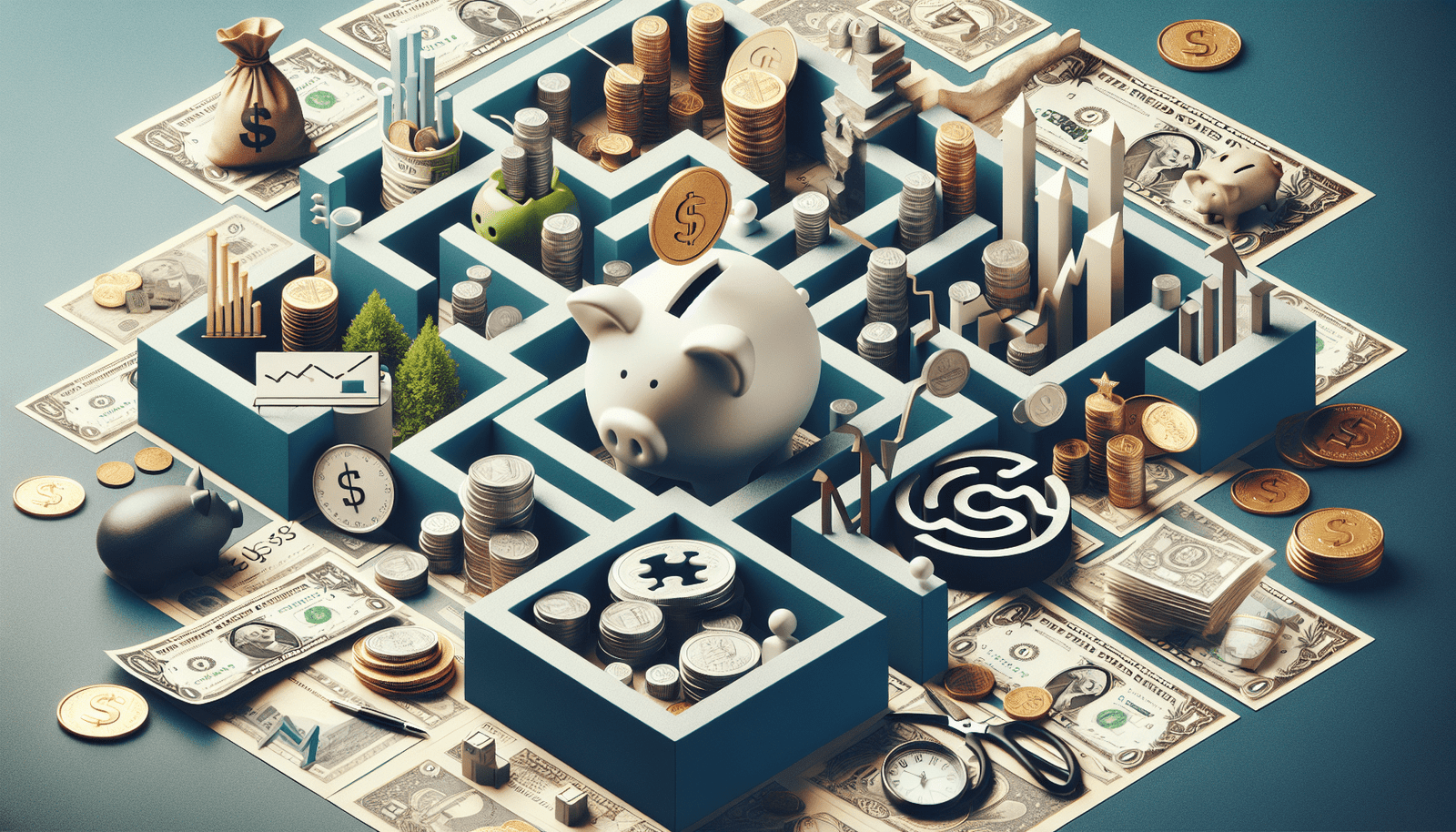Imagine a world where you no longer feel intimidated by financial jargon or confused about the complexities of money management. In this captivating article, we unravel the intricacies of the financial world and demystify the concept of money, making it accessible and relatable to everyone. From budgeting to investing, we will take you on a friendly journey of discovery, empowering you with the knowledge and confidence needed to navigate your personal finances with ease. So, grab a cup of coffee, sit back, and get ready to unlock the secrets of understanding how money works.
1. Money
1.1 Definition of Money
Money is a universally accepted medium of exchange that is used to facilitate transactions and store value. It can take various forms, such as coins, banknotes, and digital currencies, and is used by individuals, businesses, and governments worldwide. Money acts as a means of payment for goods and services and enables economic activities to occur efficiently. Whether you’re buying groceries, starting a business, or investing in stocks, money plays a vital role in our daily lives.
1.2 Historical Origins of Money
The concept of money dates back thousands of years, with its origins tied to the development of human civilization. In ancient times, bartering was the primary method of trade. People would exchange goods and services directly, such as trading crops for livestock. However, this system had limitations as it relied on the coincidence of wants between two parties.
Eventually, societies started using commodities as a medium of exchange. For example, in ancient Mesopotamia, barley was used as a form of money. Over time, other commodities such as shells, salt, and precious metals like gold and silver emerged as widely accepted forms of currency. These commodities were durable, portable, and divisible, making them valuable for trade.
1.3 Functions of Money
Money serves several key functions within economies. The three primary functions of money are:
- Medium of Exchange: Money acts as a medium of exchange, allowing individuals to trade goods and services without the need for bartering. It simplifies transactions and makes economic activities more efficient.
- Unit of Account: Money provides a common unit of measurement for pricing goods and services. It allows individuals and businesses to compare the value of different items and make informed decisions about purchases or investments.
- Store of Value: Money serves as a store of value, meaning it can be saved and used in the future. Unlike perishable goods, money has durability and can retain its purchasing power over time, making it a reliable form of wealth storage.
1.4 Types of Money
Throughout history, money has taken different forms depending on the needs and advancements of societies. The types of money can be broadly categorized into two main categories: commodity money and fiat money.
Commodity Money: Commodity money refers to objects that have intrinsic value beyond their use as money. Examples include gold, silver, and precious stones. People would accept these commodities as payment due to their inherent value.
Fiat Money: Fiat money is currency that is not backed by a physical commodity but is declared by governments as legal tender. Its value is based on trust and confidence in the issuing authority. Most modern currencies, such as the US Dollar, Euro, and Japanese Yen, are fiat currencies.
1.5 Role of Central Banks in Money Supply
Central banks play a crucial role in regulating and controlling the money supply within an economy. They are responsible for implementing monetary policies that aim to achieve economic stability and promote growth. Central banks have the authority to issue currency, act as lenders of last resort, and oversee the banking system.
One of the primary roles of central banks is to maintain price stability, often targeting a specific inflation rate. They achieve this by adjusting interest rates and managing the supply of money in circulation. Central banks also act as regulators, ensuring that financial institutions operate safely and efficiently. In times of crisis, central banks step in to provide liquidity to the banking system, preventing widespread financial disruptions.
2. Concept of Value
The concept of value plays a crucial role in understanding how money works. Value refers to the worth or usefulness of an item or service, which can vary among individuals and societies. It is subjective and influenced by various factors.
2.1 Value Perception
Value perception is the way individuals perceive the worth of goods or services. It is shaped by personal preferences, cultural influences, and market conditions. For example, a rare collectible item might hold high value for a collector but may have little value for someone who doesn’t appreciate the item’s significance.
Furthermore, value perception can be influenced by marketing tactics and branding. Companies often aim to create a perception that their products or services offer unique value to consumers. This perception can affect pricing decisions and consumer behavior.
2.2 Factors Influencing Value
Several factors influence the value of goods and services. These factors include:
- Supply and Demand: The relationship between supply and demand determines the value of a product in the market. When demand exceeds supply, prices tend to rise, indicating higher value. Conversely, when supply exceeds demand, prices may decrease, suggesting lower value.
- Scarcity and Rarity: Items that are scarce or rare often have higher value. For example, limited-edition products or unique works of art tend to command higher prices due to their rarity.
- Utility and Functionality: The utility or usefulness of a product can impact its perceived value. Products that provide essential functions or meet specific needs are typically valued more by consumers.
- Quality and Durability: Higher-quality products that are durable and long-lasting tend to hold their value over time. Consumers are often willing to pay a premium for goods that can stand the test of time.
2.3 Inflation and Deflation
Inflation and deflation are economic phenomena that can impact the value of money. Inflation refers to a general increase in prices over time, resulting in a decrease in the purchasing power of money. When inflation occurs, it takes more money to buy the same goods and services.
On the other hand, deflation is the opposite of inflation. It refers to a decrease in prices, leading to an increase in the purchasing power of money. While deflation may sound desirable, it can also have negative effects on an economy, such as discouraging spending and investment.
Central banks and governments closely monitor inflation and deflation rates to maintain stable economies. They may adjust interest rates and implement monetary policies to control these factors and ensure the value of money remains relatively stable.

3. Economic Systems and Money
Economic systems play a significant role in how money operates within a society. Different economic systems dictate how money is created, distributed, and allocated among individuals and institutions. Two prominent economic systems that have influenced the role of money are capitalism and socialism.
3.1 Barter System
Before the advent of currency, the barter system was the prevailing method of exchange. In a barter system, individuals would trade goods or services directly without the use of money. While bartering allowed for trade to occur, it had limitations due to the need for a double coincidence of wants and the difficulty of obtaining fair value for exchanged items.
3.2 Introduction of Currency
The introduction of currency brought about significant changes in economic systems. Currency, in the form of coins and later paper money, provided a standardized medium of exchange that made transactions more efficient. It eliminated the need for direct bartering and increased the liquidity and convenience of trade.
3.3 Capitalism and Money
Capitalism is an economic system based on private ownership of resources and the pursuit of profit. In a capitalist system, money plays a central role in facilitating economic activities. It enables individuals and businesses to invest, produce, and trade goods and services. Capitalism relies on market forces of supply and demand to determine prices and allocate resources. The accumulation of wealth and the pursuit of profit are key motivations within a capitalist system.
3.4 Socialism and Money
Socialism, in contrast to capitalism, is an economic system that aims to create a more equitable distribution of resources by collectively owning and controlling the means of production. In socialist economies, money still plays a role as a medium of exchange; however, the focus is on meeting the needs of society rather than maximizing individual profit. Governments in socialist systems aim to ensure that wealth and resources are distributed more evenly among the population.
3.5 Modern Monetary Systems
Today, most countries operate under mixed economies, which combine elements of both capitalism and socialism. Modern monetary systems vary considerably around the world, with each country adopting its own monetary policies and regulations. Central banks play a key role in managing the money supply and regulating financial institutions within these systems.
4. Money Creation and Supply
Money creation and supply refer to the process by which money enters circulation and the overall availability of money within an economy. The creation of money is a complex process involving various entities and mechanisms.
4.1 Fractional Reserve Banking
Fractional reserve banking is a system used by commercial banks to create money. When individuals deposit money in a bank, the bank is required to keep only a fraction of the deposit as reserves and can lend out the remaining portion. This system enables the expansion of the money supply beyond the initial deposits. When borrowers receive loans, the money is created as a deposit in their accounts, effectively increasing the overall money supply.
4.2 Central Banks and Monetary Policy
Central banks have the authority to control the money supply and regulate the banking system. They use monetary policy tools to influence economic conditions and achieve specific objectives, such as price stability and employment growth.
Monetary policy actions, such as adjusting interest rates and reserve requirements, affect the amount of money available within an economy. By increasing or decreasing the cost of borrowing, central banks can influence consumer spending, investment, and inflation rates.
4.3 Money Multiplier Effect
The money multiplier effect refers to the concept that a change in the monetary base, such as an increase in currency in circulation or bank reserves, can lead to a larger change in the money supply. It is based on the idea that banks can create additional money through lending and the subsequent re-depositing of those funds.
For example, if a central bank injects $100 million into the economy through open market operations, this can lead to a multiple of that amount in new loan creation and money supply expansion. The money multiplier effect highlights the interconnectedness of the banking system and its role in amplifying the initial injection of funds.
4.4 Quantitative Easing
In times of economic crisis or recession, central banks may implement unconventional monetary policy measures like quantitative easing (QE). QE involves the purchase of financial assets, usually government bonds, by the central bank to increase the money supply and stimulate economic activity.
By increasing the demand for assets, QE aims to lower interest rates, encourage lending, and boost economic growth. However, the effectiveness of QE is widely debated, as its impact on inflation, asset prices, and long-term economic stability can vary.

5. Monetary Transactions
Monetary transactions refer to the various methods and systems used to exchange money for goods, services, or financial assets. Over time, advancements in technology have transformed the way we conduct monetary transactions.
5.1 Payment Methods
Traditional payment methods include cash, checks, and money orders. Cash transactions involve physical currency, providing immediate value exchange. On the other hand, checks and money orders involve written orders to transfer specific amounts from one account to another.
In recent years, electronic payment methods such as credit and debit cards have become more prevalent. These methods rely on digital networks to process transactions and provide convenience and security to consumers.
5.2 Banking Systems
Banking systems serve as intermediaries for monetary transactions. They provide services that include accepting deposits, facilitating payments, and providing loans. Banks play a vital role in the economy by channeling funds from savers to borrowers. They offer convenience and security for financial transactions and are regulated to ensure stability and consumer protection.
5.3 Electronic Funds Transfer
Electronic Funds Transfer (EFT) is a system that enables the transfer of funds electronically between accounts. EFT allows for various transactions, such as direct deposit of salaries, online bill payments, and wire transfers. It eliminates the need for paper-based payments and accelerates the speed and efficiency of transactions.
5.4 Cryptocurrencies
Cryptocurrencies, such as Bitcoin and Ethereum, have gained popularity in recent years as an alternative form of digital money. They use cryptographic technology and operate on decentralized networks known as blockchain. Cryptocurrencies enable peer-to-peer transactions without the need for intermediaries like banks. While they offer advantages such as increased privacy and lower transaction fees, cryptocurrencies also come with unique risks and regulatory challenges.
6. Financial Institutions and Money
Financial institutions play a critical role in the management, storage, and allocation of money. They provide a wide range of services, including banking, investment, insurance, and securities trading.
6.1 Commercial Banks
Commercial banks are the most common type of bank that provides services to individuals and businesses. They accept deposits, facilitate lending, and offer various financial products such as savings accounts, mortgages, and personal loans. Commercial banks serve as the primary institution for monetary transactions, providing customers with access to their funds and the ability to make payments easily.
6.2 Investment Banks
Investment banks specialize in providing financial advisory and intermediary services for corporations and governments. They assist in capital-raising activities, mergers and acquisitions, and securities trading. Investment banks play a crucial role in facilitating the flow of capital in the economy and providing expertise in complex financial transactions.
6.3 Credit Unions
Credit unions are member-owned financial cooperatives that offer services similar to traditional banks. However, credit unions are structured differently, with members sharing ownership and having a say in the institution’s operation. Credit unions focus on serving their members’ needs, often providing lower loan rates and higher savings rates compared to commercial banks.
6.4 Insurance Companies
Insurance companies provide financial protection against risks such as illness, accidents, or property damage. They collect premiums from policyholders and use the funds to pay out claims when necessary. Insurance allows individuals and businesses to transfer risk and protect their assets, providing financial security and peace of mind.
6.5 Stock Markets
Stock markets are centralized exchanges where securities, such as stocks and bonds, are bought and sold. They provide a platform for companies to raise capital by selling shares to investors. Stock markets enable individuals and institutions to invest in the growth and profitability of publicly traded companies, allowing for wealth creation and economic development.

7. Personal Finance and Money Management
Personal finance refers to the management of one’s financial resources to meet individual or household objectives. Money plays a crucial role in personal finance, and effective money management is essential in achieving financial goals.
7.1 Budgeting
Budgeting is the process of creating a plan to manage income and expenses. It involves tracking income sources, setting spending limits, and prioritizing financial goals. Effective budgeting helps individuals make informed financial decisions, avoid overspending, and allocate resources efficiently.
7.2 Saving
Saving is the practice of setting aside a portion of income for future use. It enables individuals to build emergency funds, plan for major expenses, or invest for long-term goals like retirement. Saving is an essential component of financial stability and provides a safety net during unexpected events.
7.3 Investing
Investing involves allocating money with the expectation of generating a return or profit. It typically involves purchasing financial assets such as stocks, bonds, real estate, or mutual funds. Investing allows individuals to grow their wealth over time, but it also comes with risks and requires careful consideration of one’s risk tolerance and financial goals.
7.4 Debt Management
Debt management involves effectively managing the borrowing and repayment of funds. It includes strategies to minimize debt, prioritize repayments, and manage interest costs. Successful debt management helps individuals avoid financial stress, maintain good credit, and work towards becoming debt-free.
7.5 Retirement Planning
Retirement planning involves preparing financially for the post-employment phase of life. It includes estimating future expenses, determining savings targets, and selecting appropriate retirement accounts or investment vehicles. Planning for retirement allows individuals to maintain their desired lifestyle and financial security during their golden years.
8. Understanding Interest
Interest is a vital component of financial transactions and plays a significant role in how money works. It refers to the cost or reward for borrowing or lending money. Understanding interest is crucial for making informed decisions about loans, investments, and credit.
8.1 Types of Interest
There are two primary types of interest: simple interest and compound interest.
Simple Interest: Simple interest is calculated only on the initial amount of money borrowed or invested. It does not take into account any interest earned or charged during the period. Simple interest is often used for short-term loans or investments.
Compound Interest: Compound interest is calculated not only on the initial principal but also on any interest earned or charged over time. It allows for the compounding of interest, resulting in exponential growth or accumulation. Compound interest is commonly used for long-term investments, mortgages, and credit card debt.
Compound Interest
Compound interest can have a significant impact on the growth of investments or the accumulation of debt over time. The compounding effect means that interest earns interest, leading to exponential growth. In the context of investments, compound interest allows for the growth of the initial principal and any accumulated earnings.
Conversely, compound interest can work against borrowers, especially on long-term loans with high-interest rates. The longer the borrowing period, the more interest accumulates, potentially resulting in a significant repayment burden.
8.2 APR and APY
Annual Percentage Rate (APR) and Annual Percentage Yield (APY) are measures used to express the cost or return of borrowing or investing money.
APR: APR represents the annual cost of borrowing funds, including interest and any additional fees or charges. It allows borrowers to compare the costs of different loans. Lenders are required to disclose the APR before entering into a loan agreement.
APY: APY is the annualized rate of return on an investment, taking into account compound interest or dividends. APY provides a more accurate measure of the total return on an investment, including both principal and interest.
8.3 Understanding Credit
Credit is the ability to borrow money or access goods and services with the expectation of repayment at a later date. It plays a critical role in the modern economy, enabling individuals and businesses to make purchases or investments before having the necessary funds.
Understanding credit involves recognizing the factors that contribute to creditworthiness, such as credit history, income, and existing debts. Maintaining good credit allows individuals to access favorable borrowing terms and lower interest rates, while poor credit can limit access to credit and result in higher borrowing costs.

9. The Role of Government in Money
Governments play a vital role in overseeing and regulating monetary systems and financial activities. They implement policies and regulations to ensure the stability and integrity of the economy.
9.1 Fiscal Policy
Fiscal policy involves the government’s use of taxation and spending to influence the economy. It aims to achieve economic stability, reduce unemployment, and promote economic growth. Governments use fiscal policy tools, such as adjusting tax rates and allocating budgets, to influence aggregate demand and manage economic cycles.
9.2 Monetary Policy
Monetary policy focuses on the management of the money supply and interest rates to control inflation, stabilize currencies, and promote economic growth. Central banks are typically responsible for formulating and implementing monetary policy. They use tools like open market operations, reserve requirements, and interest rate adjustments to manage the money supply and influence economic conditions.
9.3 Currency Manipulation
Currency manipulation refers to deliberate actions by governments or central banks to influence the value of their currency in the foreign exchange market. Countries may manipulate their currency to gain a competitive advantage in international trade, stimulate exports, or protect domestic industries. Currency manipulation can have significant effects on global trade flows and the relative value of currencies.
9.4 Financial Regulation
Financial regulation encompasses laws and regulations that govern financial institutions, markets, and transactions. It aims to protect consumers, maintain market integrity, and prevent systemic risks. Regulatory bodies, such as financial supervisory authorities, oversee compliance and enforce regulations to ensure the stability and transparency of financial systems.
10. Global Economy and Money
The global economy relies on the interaction of different currencies and the facilitation of international trade. Money plays a crucial role in global economic activities and is influenced by various factors, including exchange rates and international financial institutions.
10.1 Foreign Exchange Market
The foreign exchange market is a global marketplace for buying and selling currencies. It allows for the exchange of one currency for another, facilitating international trade and investment. Currency exchange rates fluctuate based on market forces, including supply and demand, economic indicators, and geopolitical factors.
10.2 International Trade
International trade involves the exchange of goods and services between countries. Money acts as a medium of exchange in these transactions, enabling the valuation and payment for imports and exports. Trade deficits and surpluses impact countries’ balance of payments and can influence the value of their currencies.
10.3 International Monetary Fund
The International Monetary Fund (IMF) is an international organization that promotes global monetary cooperation, facilitates trade, and fosters sustainable economic growth. It provides financial assistance to member countries facing financial crises, conducts economic research, and offers policy advice. The IMF plays a crucial role in maintaining stability in the global monetary system and promoting sound economic policies.
In conclusion, understanding how money works is essential for navigating the complexities of the modern economy. Money serves as a medium of exchange, a unit of account, and a store of value, enabling individuals and societies to meet their economic needs. It has evolved throughout history, taking different forms and playing different roles within various economic systems. Money creation, supply, and management are influenced by central banks, fiscal policies, and monetary policies. Personal finance and money management skills are necessary for individuals to achieve their financial goals. Governments exert significant influence over money through fiscal policies, monetary policies, and financial regulations. In the global economy, money facilitates international trade and is subject to the dynamics of foreign exchange markets and international financial institutions. By understanding how money operates, we can make informed decisions and participate actively in economic activities that shape our lives and the world around us.
